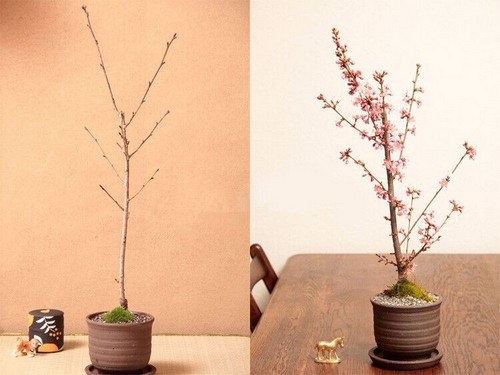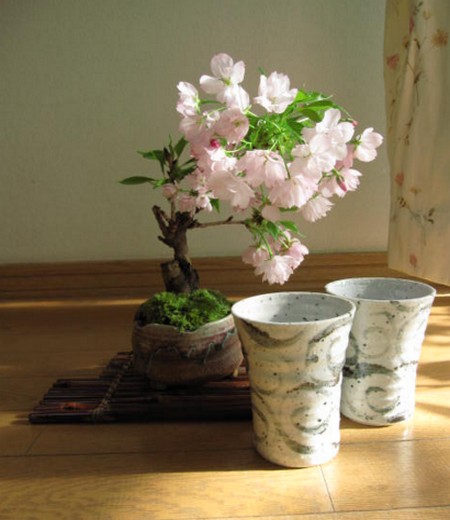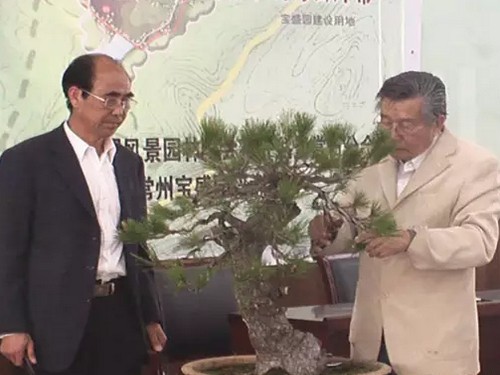Grafting technique of potted cherry blossoms
Cherry blossom is an important ornamental tree species in the garden. when it blossoms in early spring, the large and gorgeous flowers cover the whole tree and even bend the branches. Then the branches and leaves are luxuriant, the shade is like a cover, and the bark is bright and striped. Suitable for roadside and courtyard greening and beautification.

[cultivation and selection of rootstocks and scions]
Grafted cherry blossoms should not use mountain peaches and apricots as rootstocks because of their poor affinity, especially in the later stage. The seeds of mountain cherry, mountain cherry blossom or sweet cherry varieties are generally used as rootstocks. Fine varieties of cherry blossoms generally have no seeds. Colt rootstock was introduced and developed by tissue culture in the 1980s. It is suitable to be used not only as sweet cherry rootstock, but also as cherry rootstock. The scion is made of stout branches of fine varieties. For inferior big trees, they can be used as large rootstocks for high replacement.
[grafting method]
One is budding in autumn. The rootstocks propagated with seeds can reach more than 70 cm in height in autumn, which is suitable for budding. The grafting method can be either T-shaped bud grafting or embedded bud grafting. After that, the rootstocks were not cut, and the rootstocks above budding were cut off in the spring of the following year to promote budding. Grow for 1 year to form strong seedlings.
The second is grafting in summer. The rootstock seedlings that take root by pressing are moved into the nursery in the second year, and the scion has begun to Lignification in summer, which can be grafted with T-shaped buds or square buds, then grafted in the middle of the rootstock and coring at the top. After survival, cut off the rootstocks above the buds, and the lower rootstocks retain the old leaves, erase the sprouts, promote the growth of buds, and form strong seedlings after autumn.
A younger brother asked me about the grafting technology the day before yesterday. In fact, I only knew some grafting techniques, but I never put it into practice. I was ashamed! Next, let's introduce the grafting technology of cherry blossoms!
1. Selection of rootstock varieties:
It is best to choose the seedlings of Sakura as the rootstock. From the middle of December to the end of January, the annual branches which had been basically lignified were selected from the exuberant mother tree of Sakura, and the 8~10cm segments were cut from bottom to top as rootstocks.
2. Grafting: the rootless rootless rootstock cutting method is adopted, which has the advantage of simple and practical operation technology. It can be grafted on the rootstock with smaller ground diameter to improve the utilization rate of rootstock, and the grafting time can be postponed to the end of March, and it can be regrafted repeatedly, which can effectively improve the survival rate of grafting, and the economic benefit is remarkable.
Grafting steps:
(1) preparation of grafting materials
The scion adopts fully lignified sturdy new shoots of the same year, which requires full development of buds and no diseases and insect pests; a special grafting knife should have a plane; the binding material should be made of organic plastic film with good tension and strong elasticity, and the long strips of 30cm and wide 1.5~2.0cm should be cut off for backup.
(2) cutting rootstocks
Before grafting, use the stock (8~10cm) prepared to be intercepted, and cut the cut obliquely from the top of the stock, slightly with 0.5~0.7mm, and cut down longitudinally, its depth is that the wood is not hurt, the length of the cutting surface is about 2cm, and the cutting surface should be smooth and lint-free.
(3) placing scion
Both ends of the scion with 1 bud are cut into an inclined plane, and the scion length is 2.5~3cm. When cutting the scion, the scion with the same or smaller diameter as the rootstock should be selected, first cut the scion branch at the 0.5cm above the bud, then cut the short cutting surface of 50 °from the front of the bud, and then cut the cutting surface at the 0.5cm of the bud on the back of the bud, the depth of which is no damage to the wood, and the length is about longer than the cutting surface of the rootstock. Then, insert the cut scion base slope outward into the rootstock incision, insert the rootstock incision close to the bottom, and pay attention to aligning the rootstock cortex (cambium).
(4) binding film
Immediately after the scion is placed, it is bound with exposed buds with plastic film, tightly cut noodles and the top of ear bud branches are bound from bottom to top, and the hands should be kept steady. After grafting, it should be uniformly hidden in the soil and cut after the beginning of spring.
(5) Supplementary connection
After 30 days of grafting, the survival of the scion was checked, the grafting was carried out, and it could be regrafted in March. Through supplementary connection, the survival rate can reach more than 95%.
Time: 2019-06-12 Click:
- Prev

Propagation Technique of Cherry Blossom in Pot--Cutting Method
Cherry belongs to deciduous tree of Rosaceae, plant height 5~25cm, composed of 3~5 flowers umbrella or raceme, color has white, pink, single or double petals, flowers and leaves at the same time or flowers first and then leaves, flowering 4-5 months. When spring flowers bloom, flowers are full of trees, competing for beauty, anthocyanins are fresh and elegant
- Next

Technical guide for modeling of pine bonsai
Every creature in nature is affected by other creatures, and people interfere with the growth of pine trees through technical means, which is a manifestation of this effect. To this day, this phenomenon still exists, which is the prevalence of potted plants. Pine tree is of great significance in Chinese traditional culture, symbolizing the character of perseverance.
Related
- Fuxing push coffee new agricultural production and marketing class: lack of small-scale processing plants
- Jujube rice field leisure farm deep ploughing Yilan for five years to create a space for organic food and play
- Nongyu Farm-A trial of organic papaya for brave women with advanced technology
- Four points for attention in the prevention and control of diseases and insect pests of edible fungi
- How to add nutrient solution to Edible Fungi
- Is there any good way to control edible fungus mites?
- Open Inoculation Technology of Edible Fungi
- Is there any clever way to use fertilizer for edible fungus in winter?
- What agents are used to kill the pathogens of edible fungi in the mushroom shed?
- Rapid drying of Edible Fungi

